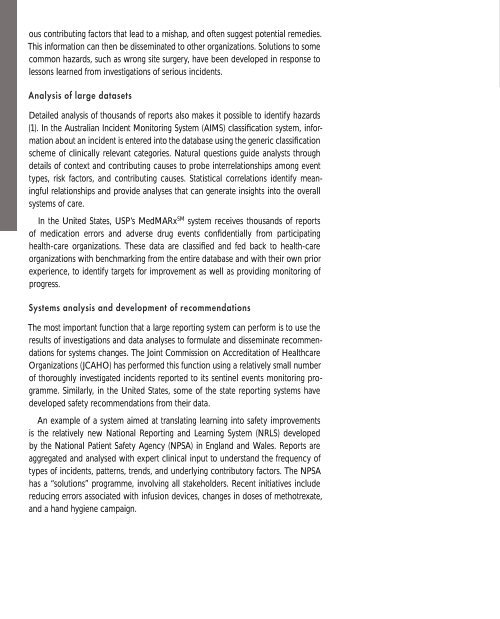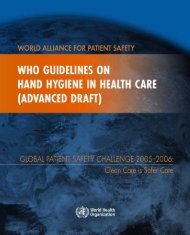Adverse event reporting.pdf
Adverse event reporting.pdf
Adverse event reporting.pdf
You also want an ePaper? Increase the reach of your titles
YUMPU automatically turns print PDFs into web optimized ePapers that Google loves.
ous contributing factors that lead to a mishap, and often suggest potential remedies.<br />
This information can then be disseminated to other organizations. Solutions to some<br />
common hazards, such as wrong site surgery, have been developed in response to<br />
lessons learned from investigations of serious incidents.<br />
Analysis of large datasets<br />
Detailed analysis of thousands of reports also makes it possible to identify hazards<br />
(1). In the Australian Incident Monitoring System (AIMS) classification system, information<br />
about an incident is entered into the database using the generic classification<br />
scheme of clinically relevant categories. Natural questions guide analysts through<br />
details of context and contributing causes to probe interrelationships among <strong>event</strong><br />
types, risk factors, and contributing causes. Statistical correlations identify meaningful<br />
relationships and provide analyses that can generate insights into the overall<br />
systems of care.<br />
In the United States, USP’s MedMARx SM system receives thousands of reports<br />
of medication errors and adverse drug <strong>event</strong>s confidentially from participating<br />
health-care organizations. These data are classified and fed back to health-care<br />
organizations with benchmarking from the entire database and with their own prior<br />
experience, to identify targets for improvement as well as providing monitoring of<br />
progress.<br />
Systems analysis and development of recommendations<br />
The most important function that a large <strong>reporting</strong> system can perform is to use the<br />
results of investigations and data analyses to formulate and disseminate recommendations<br />
for systems changes. The Joint Commission on Accreditation of Healthcare<br />
Organizations (JCAHO) has performed this function using a relatively small number<br />
of thoroughly investigated incidents reported to its sentinel <strong>event</strong>s monitoring programme.<br />
Similarly, in the United States, some of the state <strong>reporting</strong> systems have<br />
developed safety recommendations from their data.<br />
An example of a system aimed at translating learning into safety improvements<br />
is the relatively new National Reporting and Learning System (NRLS) developed<br />
by the National Patient Safety Agency (NPSA) in England and Wales. Reports are<br />
aggregated and analysed with expert clinical input to understand the frequency of<br />
types of incidents, patterns, trends, and underlying contributory factors. The NPSA<br />
has a “solutions” programme, involving all stakeholders. Recent initiatives include<br />
reducing errors associated with infusion devices, changes in doses of methotrexate,<br />
and a hand hygiene campaign.
















